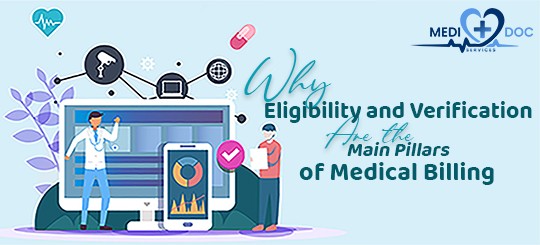
Why Eligibility and Verification Are the Main Pillars of Medical Billing
Medical billing is a crucial aspect of the healthcare industry, ensuring that providers are compensated for their services and that insurance claims are processed accurately. Within this complex system, eligibility and verification play a foundational role in the billing process. They ensure that services are covered by insurance, streamline claim approvals, and ultimately help healthcare providers get paid for their services in a timely and efficient manner.
In this blog, we will explore why eligibility and verification are considered the main pillars of medical billing and how they impact the overall success of healthcare administration.
1. Ensures Insurance Coverage
One of the primary functions of Eligibility and Verification in Medical Billing is to confirm that a patient’s insurance plan covers the specific services being provided. Insurance eligibility checks are performed before medical services are rendered, ensuring that the patient’s plan is active, valid, and covers the necessary treatments.
This process includes verifying the patient’s policy details such as:
Policyholder Information: Name, ID number, and date of birth.
Plan Type: Whether it’s an HMO, PPO, Medicaid, Medicare, or other insurance types.
Service Coverage: Whether the particular medical procedure, test, or service is covered under the policy.
Without this essential verification, healthcare providers risk performing services that may not be reimbursed, leading to financial losses for both the provider and the patient. Eligibility checks help prevent these situations and ensure that the services provided are covered by insurance.
2. Reduces Denials and Delays
Insurance claim denials and delays are a common challenge in medical billing. One of the leading causes of these denials is insufficient or incorrect eligibility verification. When claims are submitted without confirming the patient’s eligibility for coverage, the insurance company may reject or delay the payment. This can lead to a lengthy process of appeals and resubmissions, creating frustration for both the provider and the patient.
By conducting eligibility and verification processes before service delivery, healthcare providers can identify potential issues early. This includes verifying:
Coverage Limitations: Ensuring there are no restrictions on the type of services or the number of visits.
Pre-authorization Requirements: Some services may require approval from the insurance company before treatment can be provided.
Having this information upfront reduces the likelihood of claims being denied or delayed, speeding up the reimbursement process and minimizing administrative costs.
3. Prevents Financial Burden on Patients
Eligibility verification not only benefits healthcare providers but also protects patients from unexpected medical bills. If a service is provided without verifying eligibility, and the insurance claim is denied, the patient could be left with the full financial responsibility. This can lead to financial hardship and strained relationships between patients and providers.
By performing eligibility checks, medical billing teams can inform patients of any potential coverage issues before treatment, allowing them to make informed decisions about their care. This also helps in avoiding surprise bills for services that the insurance will not cover, leading to better patient satisfaction.
4. Streamlines the Billing Process
Eligibility and verification play a critical role in streamlining the medical billing process. When patient eligibility is confirmed, medical billing teams can accurately and efficiently submit claims that meet the insurance company’s requirements. This reduces the chances of rework and resubmissions, which can slow down cash flow and increase administrative overhead.
Having an efficient verification process ensures that all necessary documentation is available and correct from the beginning. The verification team can check for:
Patient Demographics: Ensuring that the personal details match the records on file with the insurance provider.
Plan Details: Double-checking coverage limits, co-pays, and out-of-pocket expenses.
Network Information: Confirming whether the provider is in-network or out-of-network with the patient’s insurance.
A streamlined and thorough verification process leads to fewer errors and quicker reimbursement, which benefits both healthcare providers and patients.
5. Enhances Patient Satisfaction
An often-overlooked benefit of eligibility and verification is its role in enhancing patient satisfaction. When patients are informed upfront about the status of their insurance coverage, they experience less anxiety regarding billing issues. Clear communication and transparency about what is covered, what is not, and what financial responsibility remains help patients feel more in control of their healthcare expenses.
Additionally, patients appreciate a seamless experience where the provider ensures their insurance details are correct and that there are no surprises down the road. This can lead to stronger patient loyalty and retention.
6. Supports Accurate Reporting and Data Analytics
Eligibility and verification also support the healthcare provider’s ability to perform accurate reporting and data analytics. By understanding the details of insurance coverage and service eligibility, providers can track and manage their reimbursement rates and the overall performance of their billing department. This data helps in making informed decisions regarding contracting with insurance providers, optimizing billing practices, and even improving service offerings.
Conclusion
In the realm of medical billing, eligibility and verification form the backbone of a successful revenue cycle. They are the first line of defence against billing errors, claim denials, and financial loss. By ensuring that patients are covered under the correct insurance plans, verifying the specifics of those plans, and proactively addressing potential issues, healthcare providers can improve cash flow, reduce administrative burdens, and enhance patient satisfaction.
Ultimately, eligibility and verification are not just procedural steps—they are critical components that enable the healthcare system to function smoothly, benefiting providers, patients, and insurance companies alike. Without a robust verification process, the medical billing system would face significant challenges that could lead to inefficiencies, errors, and financial strain.

